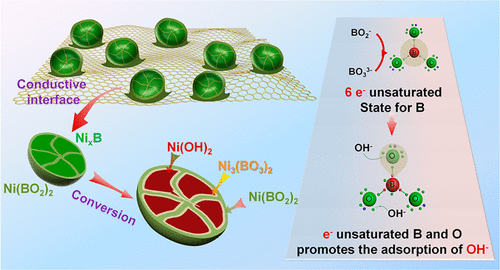Our official English website, www.x-mol.net, welcomes your feedback! (Note: you will need to create a separate account there.)
Interfacial Engineering of Nickel Boride/Metaborate and Its Effect on High Energy Density Asymmetric Supercapacitors
ACS Nano ( IF 15.8 ) Pub Date : 2019-07-22 00:00:00 , DOI: 10.1021/acsnano.9b04005 Yuanzhen Chen 1 , Tengfei Zhou 2, 3 , Lei Li 1 , Wei Kong Pang 2 , Xingmin He 3 , Yong-Ning Liu 1 , Zaiping Guo 2
ACS Nano ( IF 15.8 ) Pub Date : 2019-07-22 00:00:00 , DOI: 10.1021/acsnano.9b04005 Yuanzhen Chen 1 , Tengfei Zhou 2, 3 , Lei Li 1 , Wei Kong Pang 2 , Xingmin He 3 , Yong-Ning Liu 1 , Zaiping Guo 2
Affiliation

|
Solid materials with special atomic and electronic structures are deemed desirable platforms for establishing clear relationships between surface/interface structure characteristics and electrochemical activity. In this work, nickel boride (NixB) and nickel boride/graphene (NixB/G) are chosen as positive materials of supercapacitors. The NixB/G displays higher specific capacitance (1822 F g–1) than that of NixB (1334 F g–1) at 1 A g–1, and it still maintains 1179 F g–1 at 20 A g–1, suggesting the high rate performance. The asymmetric supercapacitor device (NixB/G//activated carbon) also delivered a very high energy density of 50.4 Wh kg–1, and the excellent electrochemical performance is ascribed to the synergistic effect of NixB, Ni(BO2)2, and graphene that fully enhances the diffusion of OH– and the electron transport. During the cycles, the prepared ultrafine NixB nanoparticles will be gradually in situ converted into β-Ni(OH)2 which has a smaller particle size than that prepared by other methods. This will enhance the utilization of Ni(OH)2 and decrease the ion diffusion distance. The electron deficient state of B in Ni(BO2)2 amorphous shell will make it easy to accept extra electrons, enhancing the adsorption of OH– at the shell surface. Moreover, Ni(BO2)2 makes strong adhesion between NixB (or β-Ni(OH)2) and graphene and protects the core structure in a stable state, extending the cycle life. The above properties of NixB/G endow the electrode good capacitive performance.
中文翻译:

硼化镍/金属硼酸盐的界面工程及其对高能量密度不对称超级电容器的影响
具有特殊原子和电子结构的固体材料被认为是在表面/界面结构特征与电化学活性之间建立明确关系的理想平台。在这项工作中,选择硼化镍(Ni x B)和硼化镍/石墨烯(Ni x B / G)作为超级电容器的正极材料。Ni x B / G在1 A g –1处比Ni x B(1334 F g –1)表现出更高的比电容(1822 F g –1),在20 A g时仍保持1179 F g –1的比电容。–1,表示高速率性能。非对称超级电容器装置(Ni xB / G ///活性炭)还提供了非常高的50.4 Wh kg –1能量密度,并且出色的电化学性能归因于Ni x B,Ni(BO 2)2和石墨烯的协同作用,充分增强了OH的扩散–和电子传输。在循环过程中,制得的超细Ni x B纳米颗粒将逐渐原位转化为比其他方法制得的粒径更小的β-Ni(OH)2。这将提高Ni(OH)2的利用率并减少离子扩散距离。Ni(BO 2)2中B的电子缺乏态无定形壳将可以很容易地接受额外的电子,提高OH的吸附-在外壳表面。而且,Ni(BO 2)2使Ni x B(或β-Ni(OH)2)与石墨烯之间具有很强的附着力,并以稳定的状态保护芯结构,从而延长了循环寿命。Ni x B / G的上述特性赋予电极良好的电容性能。
更新日期:2019-07-22
中文翻译:

硼化镍/金属硼酸盐的界面工程及其对高能量密度不对称超级电容器的影响
具有特殊原子和电子结构的固体材料被认为是在表面/界面结构特征与电化学活性之间建立明确关系的理想平台。在这项工作中,选择硼化镍(Ni x B)和硼化镍/石墨烯(Ni x B / G)作为超级电容器的正极材料。Ni x B / G在1 A g –1处比Ni x B(1334 F g –1)表现出更高的比电容(1822 F g –1),在20 A g时仍保持1179 F g –1的比电容。–1,表示高速率性能。非对称超级电容器装置(Ni xB / G ///活性炭)还提供了非常高的50.4 Wh kg –1能量密度,并且出色的电化学性能归因于Ni x B,Ni(BO 2)2和石墨烯的协同作用,充分增强了OH的扩散–和电子传输。在循环过程中,制得的超细Ni x B纳米颗粒将逐渐原位转化为比其他方法制得的粒径更小的β-Ni(OH)2。这将提高Ni(OH)2的利用率并减少离子扩散距离。Ni(BO 2)2中B的电子缺乏态无定形壳将可以很容易地接受额外的电子,提高OH的吸附-在外壳表面。而且,Ni(BO 2)2使Ni x B(或β-Ni(OH)2)与石墨烯之间具有很强的附着力,并以稳定的状态保护芯结构,从而延长了循环寿命。Ni x B / G的上述特性赋予电极良好的电容性能。











































 京公网安备 11010802027423号
京公网安备 11010802027423号